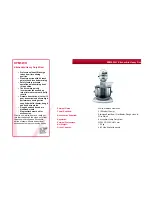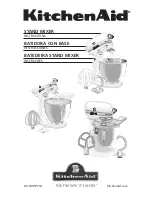
20
CC
F
dL
Fig. 2.
Belt tension
.
t
o
rePlaCe
a
lIftInG
aCtuator
:
Lift the bowl arms to the top position.
Lower the bowl arms to a pressure relief point set at approx.
midway.
It is very important that the bowl arms are low-
ered to a pressure relief point before disassem-
bling the lifting actuator.
Cut the power to the machine by removing the plug from the
socket.
Remove the three plugs for the reed contacts on the actuator.
Remove the lifting actuator from the bowl arms by removing
the pins and axle.
Remove the cotter pin that secures the actuator at the top.
Remove the cable to the actuator and lift the actuator out
from the mixing machine.
Install the new actuator.
Connect the machine to the power supply.
If replacing the lowest actuator fittings, use Lochtite 270 to
tighten the fittings
.
t
o
rePlaCe
a
belt
:
The old belt can be removed by loosening the belt tightener.
Installing a new belt:
1.
Place the belt in the wheel groove.
2.
Tighten the belt using the belt tightener
3.
Tighten the belt until the belt can be bent approximately
23/64”
(dL)
at a pressure of approx. 19 lb
(F)
, see
Fig.
2
.
4.
Run the machine with a regular production load for ap-
proximately 10 min.
5.
Check the belt tension by measuring its elasticity. If the
elasticity has changed, retighten as described in point 3.
The belt tension should be checked every 6 months.
If there is not enough belt tension, the belt will wear out
quickly, and if there is too much tension, there is a risk that
the life-span of the bearings will be considerably shortened.
Then follow the section
“Fine-tuning the reed contacts
and CE microswitch”
.
The lifting actuator has 3 proximity detectors (reed contacts)
that check the position of the bowl.
r
ePlaCInG
the
r
eed
ContaCtS
:
Remove the incorrectly charged contact and install the new
contact according to
Fig. 3
. Connect the cable as shown in
the illustration on
page 14
.
Follow the instructions below to secure the reed contact in
the correct position.
f
Ine
-
tunInG
r
eed
ContaCtS
and
Ce
mICro
-
SwItCh
:
Check that the location of the reed contacts matches up
with the marks in
Fig 3
.
Connect the reed contacts with the matching cables – see
illustration on
page 16
.
Adjust the three contacts and the CE microswitch according
to the following sequence:
1. Adjusting the top reed contact:
Contact
A
determines the top position of the bowl.
The contact must be positioned in accordance with the
mark in
Fig. 3
.
Raise the bowl to the position corresponding to mark
X,
Fig. 5
.
Adjust the top reed contact upwards until the reed LED
lights up – it is important to stop adjusting once the LED
lights up!
2. Adjusting CE-microswitch:
ERGO60
and
ERGO100
, se
Fig. 4
,
page 24
.
ERGO150
, se
Fig. 4a
,
page 24
.
3. Adjusting the reed contact for the JOG function
Contact
B
determines where the machine’s JOG function
starts, see also “Bowl lifting and JOG function” on page 3.
The contact must be positioned as shown in
Fig. 3
and
does not require any further adjustment.
4. Adjusting the bottom reed contact:
Contact
C
determines the bottom position of the bowl.
The contact must be positioned in accordance with the
mark in
Fig. 3
.
Raise the bowl to the position that corresponds to mark
Y in
Fig. 5
.
Adjust the bottom reed contact until the reed LED lights up
– it is important to stop adjusting once the LED lights up
Summary of Contents for ERGO60
Page 1: ...SPARE PART AND OPERATION MANUAL FOOD MIXER Model ERGO60 ERGO100 ERGO150 012016...
Page 16: ...16 Electrical components...
Page 17: ...17 Safety circuit...
Page 23: ...23...
Page 24: ...24...





































